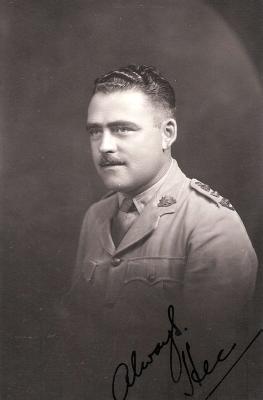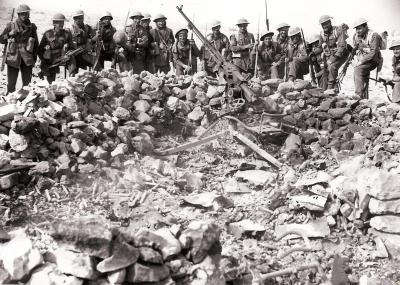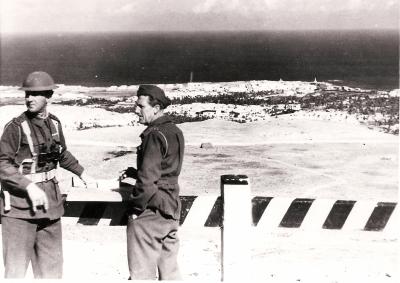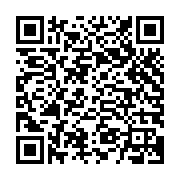World War 2, Australia, Western Australia, Fremantle, HMT Nevassa, 2/11 Battalion, 1940
1942View of ship HMT Nevassa which embarked 2/11 Battalion AIF, Lieutenant Colonel Louch commanding, on 20 April 1940
HMT Nevasa was 9071 gross tons, one funnel, twin screw, speed 14 knots, accommodation for 128-1st and 98-2nd class pasengers. She was launched 12th December 1912 by Barclay, Curle & Co., Glasgow for British India Steam Navigation Co., she started her maiden voyage from London to East Africa and Calcutta on 22nd March 1913.
In August 1914 she was taken over and converted to a troopship, and from January 1915 to 1918 was fitted as a 660 bed hospital ship. Used in the East Africa, Persian Gulf, Salonika and Mesopotamia campaigns. Later in 1918 she was used as a North Atlantic troopship, ferrrying US troops and later repatriating Allied forces. In late 1919 she resumed commercial service on the UK - East Africa and UK - Calcutta services.
In 1925 she was rebuilt as a permanent troopship with capacity for 1,000 men. Between 1939 and 1945 she trooped steadily and was used between the UK, India, Australia, Basra, Madagascar and for the Normandy Landings.
Details
Details
THE 'STUNNED' AND THE 'STYMIED', THE P.O.W. EXPERIENCE IN THE HISTORY OF THE 2/l lTH INFANTRY BATTALION, 1939~1945; A COGENT ARGUMENT FOR THE INCLUSION OF NON-OPERATIONAL STRANDS OF WARFARE IN OFFICIAL MILITARY HISTORY BY M.R. Watt B.A. A Thesis Submitted in Fulfilment of the Requirements for the Award of Master of Arts (History) at the Faculty of Arts, School of Social and Cultural Studies, Edith Cowan University 29th June, 1996
On 20 April 1940 these troops [2/11 Battalion], accompanied by details from the 2nd Australian General hospital and other units, sailed from Fremantle harbour on the British Naval troopship Nevasa for the Middle East. Anecdotes about the trip on the Nevasa (or the 'Never-Wasser' as the troops called it) give details of the lack of space, foul air, inadequate food, little water, poor hygiene facilities and shortage of supplies - particularly beer. A fair example of this was Louch' s report of 10 May when the Captain came to him with the important news that Germany had invaded Holland and Belgium and he recorded: "I was quite worried at first. I thought he was going to say the ship had run out of jam for breakfast".
The possibility that Germany and the world had continued on its own way had, it would seem, quite escaped these men or, perhaps the voyage had become a rest from reality while they came to terms with the war and their life. Notwithstanding numerous difficulties encountered during the voyage and the fear that Italy could enter the war at any time, the Master and Louch managed to bring the passengers safely through the Suez Canal to El Kantara where, two days later, on 17 May 1940, they landed and entrained for Camp Kilo 89 in Palestine …
Open in Google Maps
Nearest geotagged records:
- Australia, Western Australia, Fremantle, HMT Oxfordshire, 10 Light Horse,1919 (0.16km away)
- World War 1, Australia Western Australia Fremantle, 1915 (0.33km away)
- World War 1, Australia Western Australia Fremantle, 1915 (0.33km away)
- Pre 1914, 2nd Anglo Boer War, Western Australia, Fremantle, Western Australian Mounted Infantry, 1899 (0.34km away)
- Interwar, Australia Western Australia Fremantle, 1920 (0.37km away)
- World War 1, Australia Western Australia Fremantle, 28 Battalion, (0.41km away)
- World War 2, Australia, LOUCH, 2/11 Battalion, 1940 (0.41km away)
- World War 1, Australia Western Australia Fremantle, 1917 (0.41km away)
- World War 1, Australia, Western Australia,Fremantle, SS Main, 28 Battalion, 1919 (0.41km away)
- World War 1, Australia Western Australia Fremantle, 28 Battalion, (0.41km away)
Nearby places: View all geotagged records »
Australian Army Museum of Western Australia
Australian Army Museum of Western Australia
Other items from Australian Army Museum of Western Australia
- World War 2, Australia, Western Australia, Fremantle, HMT Nevasa
- Fremantle, HMAT Nevasa, 2/11 Battalion, 1940
- World War 2, Australia Western Australia, HMT Nevasa, 2/11 Battalion, 1942
- World War 2, Europe, 2/11 Battalion, 1942
- World War 2, Middle East, 2/11 Battalion, 1942
- World War 2, Middle East, BINKS, 2/11 Battalion, 1945
- World War 2, Middle East, 2/11 Battalion, 1945
- World War 2, Europe, 2/11 Battalion, 1940
- World War 2, Middle East, 2/11 Battalion, 1940
- World War 2, Middle East, BINKS, 2/11 Battalion, 1940
- World War 2, Middle East, 2/11 Battalion, 1940
- World War 2, Middle East, 2/11 Battalion, 1940













